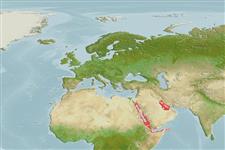Environment: milieu / climate zone / depth range / distribution range
Ecologia
marinhas; estuarina associadas(os) a recifes; intervalo de profundidade 1 - 30 m (Ref. 89707). Tropical; 31°N - 9°N, 32°E - 55°E (Ref. 5222)
Western Indian Ocean: known only from the Red Sea and Gulf of Aden (Ref. 5222). Reported from Somalia and Socotra (Yemen).
Tamanho / Peso / Idade
Maturity: Lm ? range ? - ? cm
Max length : 52.0 cm TL macho/indeterminado; (Ref. 9710); common length : 40.0 cm TL macho/indeterminado; (Ref. 5450)
Espinhos dorsais (total) : 11; Raios dorsais (total) : 14 - 16; Espinhos anais: 3; Raios anais : 8 - 9. Body robust. Serrae at the angle of the preopercle slightly enlarged; the upper edge of the operculum strongly convex. Posterior nostril of adults vertically elongate. Very similar to E. ongus which has longer pectoral fins, and a narrow white margin with broad blackish submarginal band on the median fins, which are absent or poorly developed in E. summana. Generally dark olive-brown to dark brownish gray with large pale blotches (most larger than the eye) and numerous small white spots overlying this pattern. Fins covered with small white spots, except for pectoral fins where the white spots are confined to the base.
Occurs in shallow protected coral reefs and in lagoons or brackish-water environments (Ref. 5222). No published information on the biology of this species has been found (Ref. 5222). Sold fresh in local markets (Ref. 5222).
Ciclo de vida ou comportamento de acasalamento
Maturidade | Reprodução | Desova | Ovos | Fecundidade | Larvas
Heemstra, P.C. and J.E. Randall, 1993. FAO Species Catalogue. Vol. 16. Groupers of the world (family Serranidae, subfamily Epinephelinae). An annotated and illustrated catalogue of the grouper, rockcod, hind, coral grouper and lyretail species known to date. Rome: FAO. FAO Fish. Synop. 125(16):382 p. (Ref. 5222)
Status na Lista Vermelha da UICN (Ref. 130435: Version 2024-1)
Ameaça para os humanos
Harmless
Uso pelos humanos
Pescarias: pouco comercial
Ferramentas
Relatórios especiais
Baixar XML
Fontes da internet
Estimates based on models
Preferred temperature (Ref.
123201): 25.1 - 29.3, mean 28.6 °C (based on 150 cells).
Índice de diversidade filogenética (Ref.
82804): PD
50 = 0.5000 [Uniqueness, from 0.5 = low to 2.0 = high].
Bayesian length-weight: a=0.01175 (0.00568 - 0.02430), b=3.04 (2.88 - 3.20), in cm total length, based on LWR estimates for this Genus-body shape (Ref.
93245).
Nível Trófico (Ref.
69278): 3.8 ±0.6 se; based on size and trophs of closest relatives
Resiliência (Ref.
120179): médio(a), tempo mínimo de duplicação da população 1,4 - 4,4 anos (Preliminary K or Fecundity.).
Fishing Vulnerability (Ref.
59153): Moderate vulnerability (41 of 100).
Climate Vulnerability (Ref.
125649): Very high vulnerability (83 of 100).
Nutrients (Ref.
124155): Calcium = 28.8 [12.7, 60.3] mg/100g; Iron = 0.473 [0.253, 0.981] mg/100g; Protein = 18.8 [17.2, 20.3] %; Omega3 = 0.124 [0.076, 0.198] g/100g; Selenium = 28.4 [16.3, 51.7] μg/100g; VitaminA = 183 [46, 765] μg/100g; Zinc = 1.55 [1.04, 2.18] mg/100g (wet weight);
